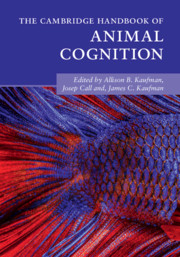Book contents
- The Cambridge Handbook of Animal Cognition
- The Cambridge Handbook of Animal Cognition
- Copyright page
- Dedication
- Contents
- Figures, Tables, and Boxes
- Contributors
- Acknowledgments
- Introduction
- Part I Communication and Language
- Part II Memory and Recall
- 6 Memory and Recall Overview
- 7 A Fish Memory Tale
- 8 Memory in Hummingbirds
- 9 Event Memory in Rats
- 10 Primate Recall Memory
- Part III Social Cognition
- Part IV Social Learning and Teaching
- Part V Numerical and Quantitative Abilities
- Part VI Innovation and Problem-Solving
- Index
- References
6 - Memory and Recall Overview
from Part II - Memory and Recall
Published online by Cambridge University Press: 01 July 2021
- The Cambridge Handbook of Animal Cognition
- The Cambridge Handbook of Animal Cognition
- Copyright page
- Dedication
- Contents
- Figures, Tables, and Boxes
- Contributors
- Acknowledgments
- Introduction
- Part I Communication and Language
- Part II Memory and Recall
- 6 Memory and Recall Overview
- 7 A Fish Memory Tale
- 8 Memory in Hummingbirds
- 9 Event Memory in Rats
- 10 Primate Recall Memory
- Part III Social Cognition
- Part IV Social Learning and Teaching
- Part V Numerical and Quantitative Abilities
- Part VI Innovation and Problem-Solving
- Index
- References
Summary
Episodic memory refers to the ability to recollect personal past events, allowing mental time travel.In contrast, semantic memory has been defined as the storage of general facts about the world. The field of comparative psychology has adopted this distinction in order to study what nonhuman animals recall about their past. The aim in this chapter is to reflect on the concept of episodic memory as well as on the experimental approaches used in comparative psychology to study this ability. A critical analysis of both the conceptualization of episodic memory and the experimental paradigms is provided.
- Type
- Chapter
- Information
- The Cambridge Handbook of Animal Cognition , pp. 117 - 139Publisher: Cambridge University PressPrint publication year: 2021
References
- 1
- Cited by

